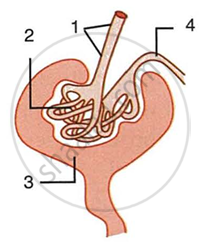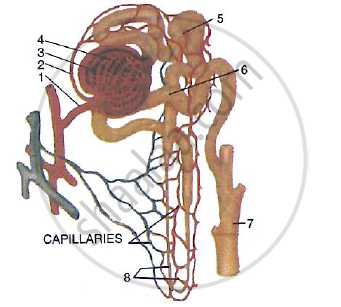Advertisements
Advertisements
प्रश्न
Study the diagram given below and then answer the questions that follow:
 |
- Name the region in the kidney where the above structure is present?
- Name the parts labelled 1, 2, 3 and 4.
- Name the stages involved in the formation of urine.
- What is the technical term given to the process occurring in 2 and 3? Briefly describe the process.
उत्तर
- Renal cortex
-
- Afferent arteriole
- Glomerulus
- Bowman's capsule
- Efferent arteriole
- Ultrafiltration, tubular reabsorption, and tubular secretion.
- The process occurring in 2 and 3 is known as ultrafiltration.
Ultrafiltration: The blood flows through the glomerulus under great pressure, much greater than in the capillaries elsewhere. The reason for this greater pressure is that the efferent (outgoing) arteriole is narrower than the afferent (incoming) arteriole. This high pressure (hydrostatic pressure) causes the liquid part of the blood to filter out from the glomerulus into the renal tubule. This filtration under extraordinary force is called ultrafiltration.
APPEARS IN
संबंधित प्रश्न
Why is it necessary to excrete waste products?
Differentiate between the following pair on the basis of what is indicated in the bracket.
Ureter and Urethra [function]
What are the methods used by plants to get rid of their waste products?
Differentiate between
tannins and resins
Answer the following in short.
List five waste products of plants.
The following diagram represents a mammalian kidney tubule (nephron) and its blood supply.

Parts indicated by the guidelines 1 to 8 are as follows:
1. Afferent arteriole from renal artery
2. efferent arteriole
3. Bowman’s capsule
4. Glomerulus;
5. Proximal convoluted tubule with blood capillaries;
6. Distal convoluted tubule with blood capillaries;
7. collecting tubule;
8. U-shaped loop of Henle
Study the diagram and answer the question that follow:
Where does ultrafiltration take place?
Describe in brief how urine is produced in the human body.
Given below is a simple diagram of the human kidney cut open longitudinally. Answer the following questions:
c
(v) Write two differences in the composition of the blood flowing through blood vessels A and B.
Write the functional activity of the following structure: Kidney
Adult frog is an amphibian, its mode of excretion is ______.
